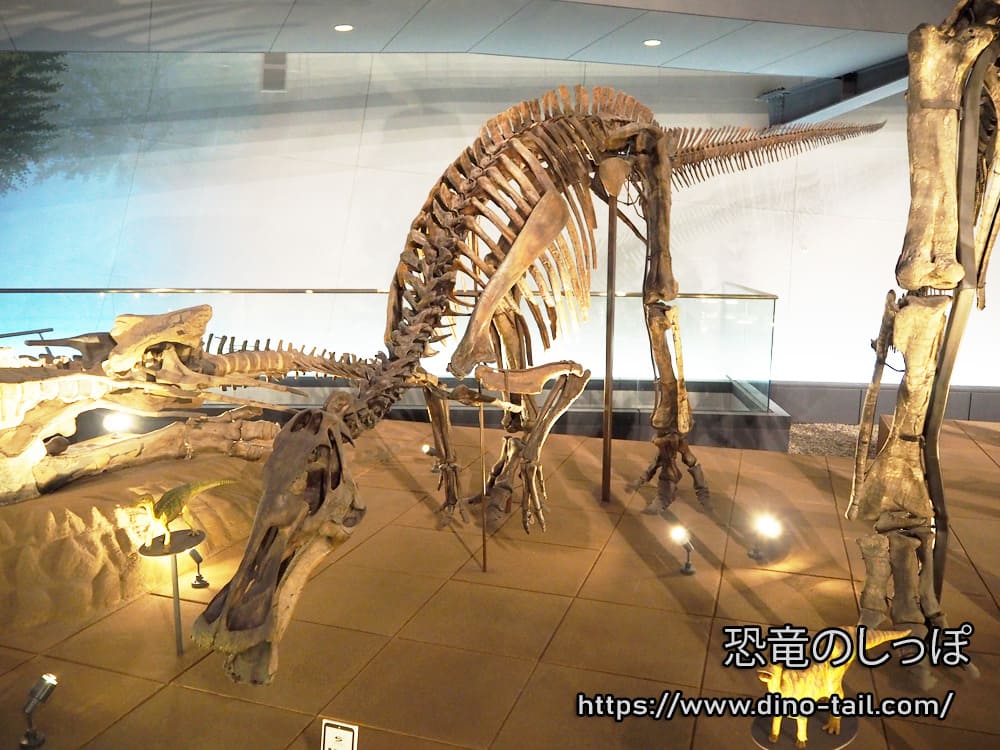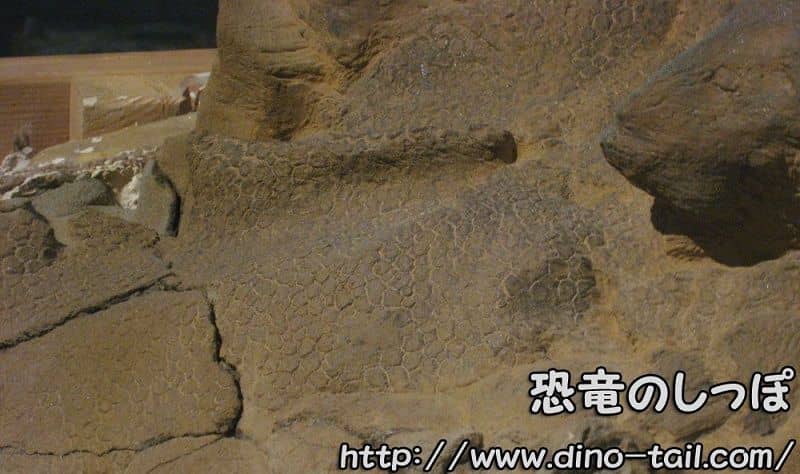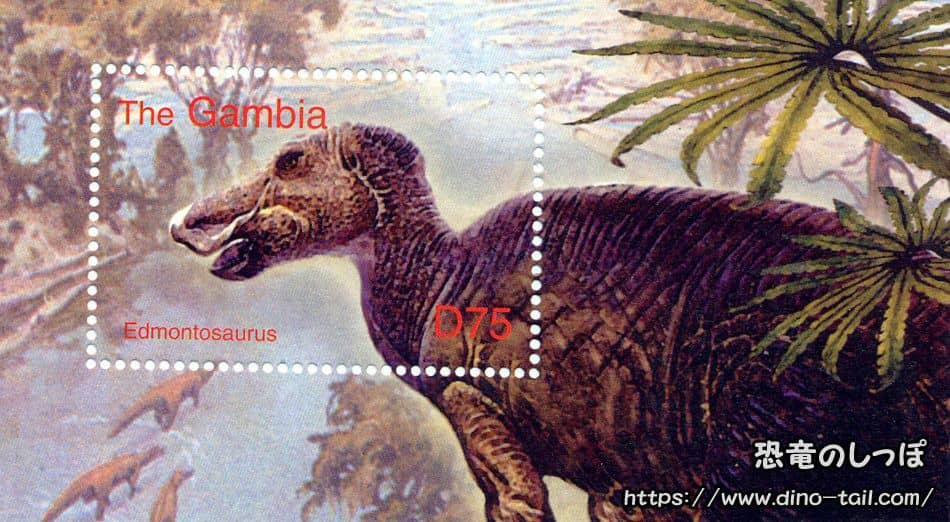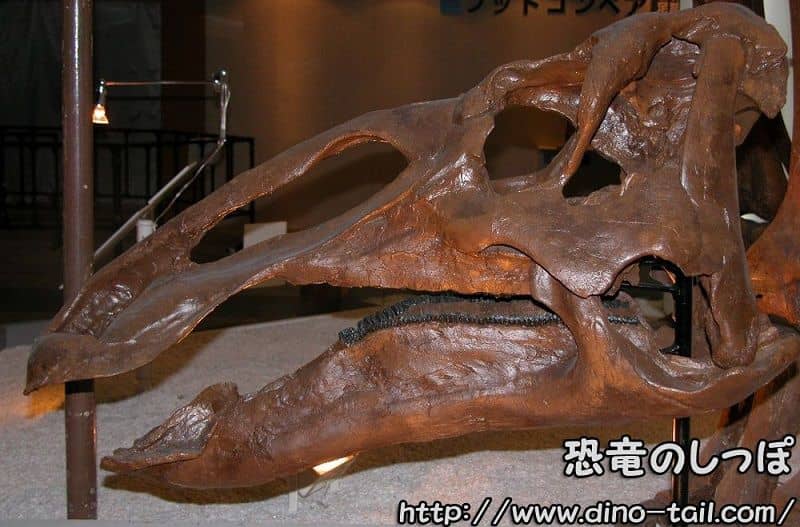About Edmontosaurus
| Scientific Name (Genus) | Edmontosaurus |
| Meaning of Name |
Lizard from Edmonton
Edmonton (Edmonton Formation) [Place Name] -saurus (lizard) [Greek] |
| Classification | Ornithischia, Ornithopoda (Hadrosauridae) |
| Total Length | Approx. 9 - 12m |
| Diet | Herbivorous |
| Period | Late Cretaceous (approx. 73-66 million years ago) |
| Species |
Edmontosaurus regalis
(type species)
Edmontosaurus annectens |
| Year of Paper Publication | 1917 |
| Genus Name Publication | Lambe, Lawrence M. (1917). A new genus and species of crestless hadrosaur from the Edmonton Formation of Alberta. The Ottawa Naturalist, 31. |
Characteristics
Edmontosaurus was one of the largest duck-billed dinosaurs that lived in North America during the Late Cretaceous (about 73-66 million years ago). Its weight is estimated to have been 4000 kg.

The dental battery is visible.
Fossilized conifers have been found in its stomach area.
It had up to 60 rows of teeth in the back of its mouth, and teeth that were worn down from eating tough conifer leaves and branches were quickly replaced with new ones.
Fossils with bite marks from carnivorous dinosaurs have also been discovered.
It was likely prey for dinosaurs such as Tyrannosaurus, which lived in the same time and region.
Edmontosaurus was one of the most prosperous herbivorous dinosaurs in North America during the final age of the Cretaceous (the Maastrichtian). It is believed that they formed huge herds and were an important food source for apex predators like Tyrannosaurus. They were truly the "wildebeest of the Cretaceous," roaming the land until the very last days of the dinosaur era.

Mummy Fossils
Several skin fossils of Edmontosaurus have been found.
A mummified fossil was also exhibited at the "Dinosaur Expo 2009 - Miracle of the Desert" held in Makuhari, Chiba in 2009 (organized by Nikkei Inc.).

It became a topic of discussion after being featured in National Geographic in December 2007.
The study of Edmontosaurus, especially the detailed analysis of the famous mummified fossil "Dakota," has revealed facts beyond our imagination. According to a study published in 2022, their forefeet were not soft, fleshy pads as previously thought, but had hard, keratinous "hooves" that encased the finger bones.
This discovery suggests that Edmontosaurus had evolved a structure similar to that of ungulates like horses and rhinos to support its weight. It is strong evidence that they switched between bipedal and quadrupedal locomotion, and it is a very important discovery that greatly changes our image of their gait and ecology.

They had a muscular sac from their eyes to their nose, which they may have inflated for communication or courtship.
A Crest on its Head
In 2013, a research team from the University of New England in Australia announced that "Edmontosaurus had a rooster-like comb on its head."
A mummified soft tissue crest, 33cm long, was found on a skull fossil from western Canada. CT scans revealed no bone inside, indicating it was a soft comb.
In a few years, dinosaur books may feature reconstructions of Edmontosaurus with a crest.
Discovery and Publication

Source: Lambe, Lawrence M. (1917). A new genus and species of crestless hadrosaur from the Edmonton Formation of Alberta. The Ottawa Naturalist, 31.
In 1892, Othniel Charles Marsh described Claosaurus annectens based on a partial skull (specimen USNM 2414) excavated from the Lance Formation in Wyoming, USA. A specimen found in the same formation that year (YPM 2182) was exhibited in 1901 as the first fully reconstructed dinosaur skeleton in America.
In 1908, Charles Hazelius Sternberg excavated a Claosaurus fossil from the same Lance Formation. He reportedly sold this specimen (AMNH 5060) to Henry Fairfield Osborn of the American Museum of Natural History for $2000.
In 1912, a fossil including a skull, articulated vertebrae from the neck to the tail, ribs, a partial hip, a humerus, and most of a hind limb was excavated from the Edmonton Formation in the Horseshoe Canyon along the Red Deer River in southern Canada. Based on this fossil, cataloged as specimen NMC 2288, Lawrence Lambe described Edmontosaurus in 1917.
Later, the Claosaurus described by Marsh in 1892 (specimens USNM 2414 and YPM 2182) was reclassified as Edmontosaurus, after being temporarily assigned to Anatotitan.
A Relatively Inexpensive North American Dinosaur

Edmontosaurus is a genus of hadrosaurid that is frequently excavated. Because it is so common, it is a representative North American dinosaur that is relatively inexpensive for general fossil collectors. You can sometimes see fossils such as jaws, dental batteries (rows of teeth), and claws from the Hell Creek Formation in Montana and the Lance Formation in Wyoming for sale.
I personally own fossils of an Edmontosaurus jaw and scapula.
Edmontosaurus Stamp & Fossil Gallery

